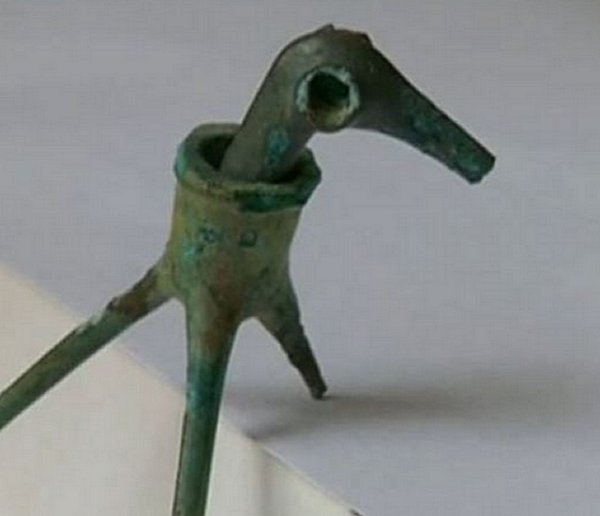MessageToEagle.com – Archaeologists working in the area of the southern town of Zlatograd in the Rhodope Mountains, Bulgaria unearthed an ancient Thracian bronze artifact in the shape of a stork’s head.

The 3,500-year-old Thracian toy – described as “the oldest children’s toy in Europe” – is made of bronze mixed with some silver, and is dated to the Late Bronze age, about 1500-1200 BC, the period of Ancient Troy and the Civilization of Mycenae,’ according to source.
It consists of a tripod holding what appears to be a stork’s head which can move and “drink water”; it weighs 30 grams.
The stork’s eyes are made of carnelian – a semi-precious gemstone found in the Rhodope Mountains in Southern Bulgaria, reports the Bulgarian National Television.
According to archaeologist Nikolay Ovcharov, it is also possible that the bronze stork may have had a religious meaning.
‘It is hard to say what exactly it was used for. It may have been a regular children’s toy but it is also quite possible that this item had some kind of a function in the religious practices of the Ancient Thracians, for example, with clairvoyance,’ Ovcharov said.
‘However, we have no way of knowing much about that because this period, the second millennium BC, was a time devoid of the written word.’
It is no accident that the Ancient Thracian toy stork from the Late Bronze Age was found near the town of Yagnevo because several Thracian sanctuaries and rock tombs have been known in the area.
Archaeologists believe these archaeological artifacts testify that the 2nd millennium BC was a period in which the Thracian civilization blossomed in the Rhodope Mountains, with its largest cult centers being the rock sanctuaries of Perperikon, Tatul, and the so called Uterus Cave, among others.
Further excavations will be conducted in several Thracian rock sanctuaries in the Rhodope Mountains, Bulgaria.
These ancient times were described by Homer in two major ancient Greek epic poems, the ‘Iliad’ and ‘Odyssey’, when the Thracians, their wine, and the magical Rhodope Mountains were cherished; the Thracians’ Rhodope Mountains were also mentioned by Herodotus who described them as the “Holy Mountain” together with the central sanctuary of god Dionysus discovered in the rock sanctuary in Perperikon.
MessageToEagle.com
Source: Archaeology in Bulgaria







